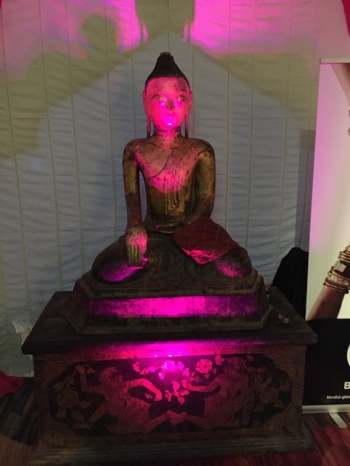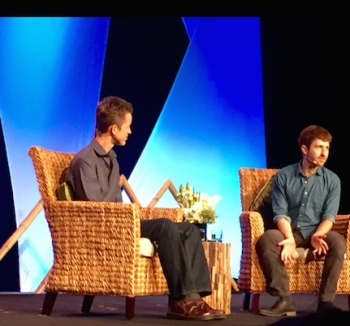As I approach the magnificently remodeled San Francisco Marriott in Union Square, I become keenly aware of the vast differences in karmic circumstances that exist in this world of “endurance.” Walking down the street, I have to be careful not to trip over the sleeping homeless man in the doorway, his dirty jeans hanging half-way off his body, huddled to stay warm through the moist, cool night of this city of modern wonder and riches. As a follower of Shakyamuni, the Enlightened Buddha who promised an end to suffering if one follows the Eightfold Path, when the lights of the hotel lobby fill my eyes I wonder what “Wisdom 2.0” has to offer in terms of freeing humanity from suffering.
Buddhism is based on the words of the Buddha Shakyamuni, the historical Buddha of our time. He taught the Four Noble Truths: there is suffering, there is a cause of suffering, there is a cessation of suffering, and there is a way leading to the cessation of suffering, which is the Eightfold Path. All schools of Buddhism are founded on these teachings.
“Wisdom 2.0” is a movement that has been taking place over the last few years within IT companies and corporate America. It is based on a belief in the inherent benefits of wisdom, compassion, and mindfulness for individuals and society as a whole. The conference organizers do not present it as Buddhist, yet this year the proceedings open with the construction of a Sand Mandala by monks from Drepung Loseling Monastery. As the mandala takes shape over the three days, the central deity is revealed to be the bodhisattva of wisdom, Manjushri.
There are a few recognizable Buddhist teachers speaking. Most notable are Jack Kornfield from Spirit Rock Meditation Center, who is referred to as a “wisdom teacher” rather than a Buddhist teacher in the conference billing, and Roshi Joan Halifax. Most of the speakers are community activists, corporate leaders, scientists, artists, and therapists.
“Wisdom 2.0” is the brainchild of Soren Gordhamer, the author of the book Wisdom 2.0: Ancient Secrets for the Creative and Constantly Connected (2009). Like the “Wisdom 2.0” conference itself, the book is aimed at bringing mindfulness practice to the fast-paced, modern, technological world. Gordhamer has worked with Richard Gere and the Dalai Lama in the past, and the influence of Buddhism saturates his writing, just as it does the conference.
The specific title of this conference is “Wisdom 2.0 Business.” Gordhamer’s vision is to bring mindfulness, compassion, and wisdom into the business world and the workplace, where people spend the majority of their daily lives. He opens the conference by asking attendees to take a moment to notice their breath, to notice its rise and fall in their body, to be aware of where they are in this moment. This is a classic mindfulness meditation technique. While most of the ideas and techniques are Buddhist, they are presented without the word “Buddha” attached to them. The depth of the Buddha’s teachings is never touched.
“Wisdom 2.0” leaves Shakyamuni’s essential teachings at the door with the homeless man—not allowed into the multi-million dollar hotel conference rooms. No one without a conference badge is allowed into the conference area; the gates to the mandala of “Wisdom 2.0” with its meditation rooms, yoga rooms, conversation rooms, and brilliant speakers are closed. If you don’t have enough merit to afford entry to the conference, you cannot access the tables with smart watches that remind you to breathe, the apps to help you invest mindfully, or the meditation magazine tables. Inside, we are given a sense of Shambhala, a utopian society where suffering is eradicated through meditation techniques and good intention.
The first three Noble Truths are left out of the conference. Instead we go directly to aspects of the Eightfold Path, focusing on right livelihood, right effort, right mindfulness, right concentration, right view, and right intention, with no faith in a historical teacher, supra-being, or lineage necessary. The teachings are sanitized and served with a streamlined efficiency that Steve Jobs would be proud of, a form of iBuddhism that is pleasing to the eye and the mind. Statues of the Buddha sit here and there, and the backdrop to the speakers, as they give their 20-minute TED-style talks, is a white knot of eternity. These speakers give no moral imperatives outside of social justice and equality, and the human capacity to succeed given the right tools.
The list of companies attending the conference is impressive. There are speakers from Instagram, Starbucks, Black Rock Investment, Google, LinkedIn, and Facebook, to name a few. They all speak about the importance of mindfulness to enhance productivity, innovation, and well-being in the workplace. They blend in seamlessly with the neuroscientist who speaks passionately about the benefits of meditation and the pressing need to sculpt society and the human being through the new-found scientific concept of neuroplasticity, where meditation can be a panacea for all wounds, both new and old.
It appears to work. Just as at other meditation retreats, the attendees go through catharsis. A couple walks away to sit by the pool. I ask them if they feel this is a Buddhist conference and they respond they had no idea any of the ideas being presented were Buddhist. Others are crying, deeply touched by the compassion meditation led by Roshi Joan Halifax on the third morning. People walk around feeling overwhelmed and dazed by the barrage of information and the continuous reminder to connect with their breath and heartbeat.
Yet, the underlying discomfort of being (Skt. duhkha) that the Buddha pointed out is not discussed. There is no reference to the truth that there is a root of suffering, which is the ego. We are not challenged to look at self-clinging as a cause of suffering; there is no indication or direction as to how to be free from birth, old age, sickness, and death—the sufferings from which the Buddha indicated we should seek freedom. Rather, the speakers are inspiring and glorious in their presentation of making a better samsara through the techniques presented. The audience is enraptured with the idea that we have the key to bring humanity out of its suffering through technology, science, and an undefined principle of wisdom. The conference has tones of a gospel revivalist meeting where everyone is saved through the beneficence and grace of modern science, technology, and ancient meditation techniques. This makes me wonder, as I leave the conference and avoid looking at the worn-out homeless man on the street, holding out a cup with a few quarters and a dime in it: if you teach Buddhism without the Buddha in it, even if society becomes better, will anyone actually attain enlightenment?
For more information, see:

















